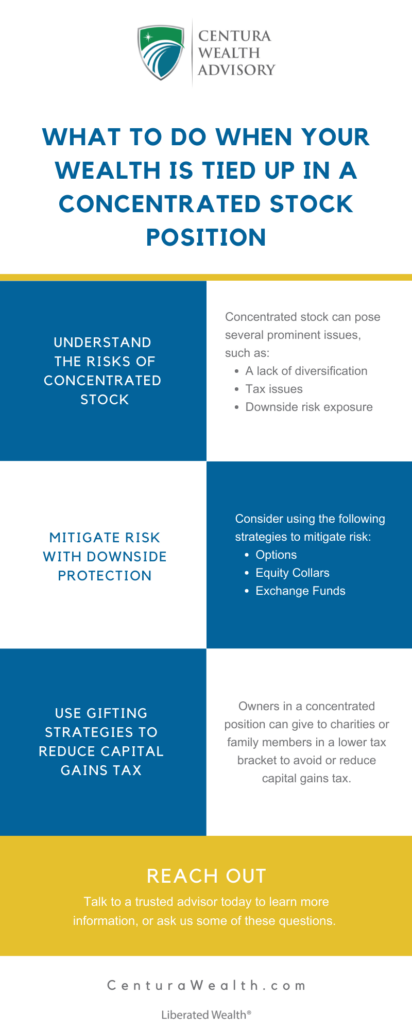Strategies For Managing a Concentrated Stock Position
At Centura, we are dedicated to providing superior risk-adjusted returns and employing passive, active, and alternative investment strategies in our portfolio designs for our clients. As per our investment philosophy, our goals are to:
- Build diversified, cost-efficient portfolios
- Integrate alternative investments
- Implement tax mitigation strategies
We believe that to achieve these goals, our role is to act as stewards for our clients through:
- Helping them fully understand their investments and portfolios
- Outlining their options
- Providing purposeful strategies to ensure their success.
One of the tools we use to connect to our clients is our podcast, Live Life Liberated. It provides and breaks down relevant financial information in a detailed discussion geared towards our clients.
Listen to “What To Do When Your Wealth Is Tied up in a Concentrated Stock Position?” for an informative discussion from Sean Clark and David Cariani on what concentrated stock is and how an investor can mitigate risk in a concentrated stock position.

Understanding Concentrated Stock and the Risks
Concentrated stock can be defined as “the holding of a single stock that represents 10% or more of your overall portfolio.”
Those who may find themselves in a position of high concentrated stock include:
- Founders of companies
- Long-term executives
- Long-term investors
- Pre-IPO employees
Concentrated stock can “cut both ways” by bringing great fortune by increasing the total value of a portfolio as well as posing several prominent issues. These issues include but are not limited to:
- A lack of diversification
- Tax issues
- Downside risk exposure
For example, Yahoo’s stocks peaked in 2000, benefiting investors with a concentrated position, before severely dropping a few years later and tanking the portfolios of investors.
Mitigating Risk with Downside Protection
While a concentrated stock position can prove to be a high-risk investment, there are strategies investors can employ to minimize this risk.
Options
Options can be used to mitigate downside risk exposure through hedging strategies that increase in value when the investments you are protecting drop.
Sean and David simplify this practice as “buying insurance to the downside of your position or giving up the upside of this position and [earning] income for doing that.”
Options can include:
- Listed Options
- Publicly Traded Options
- Over-The-Counter Derivative Contracts
Equity Collars
The equity collar method includes “buying an out-of-the-money put option while simultaneously writing an out-of-the-money call option.” This combination provides downside protection for the owner because the put option gives them the right to sell their stock position at a given price in the future while the sale of the call option provides the investor with the income they can use to pay for the purchase of the put option.
Sean and David describe this flexible strategy as “giving up part of the upside to buy insurance for the downside.”
Exchange Funds
Owners can also choose to enter their stock in a non-taxable event, or exchange fund. An exchange fund is an arrangement or partnership between shareholders of different companies in which owners pool their large holdings of a single stock for exposure to a broader index.
Exchange funds allow the owners to:
- Diversify their holdings while maintaining their concentrated position if they wish to hold onto their stock
- Avoid taxes from capital gains
Use Gifting Strategies to Reduce Capital Gains Tax
Gifting to a Charity
An owner that has a highly appreciated stock with unrealized gains may benefit from a charitable gifting strategy. The owner collects credit for the charitable gift while the receiving organization gets the full value of the gift at the time it was given.
David and Sean break down this strategy in the following scenario:
If an owner has 30% basis and 70% gains and chooses to give away $100,000 of that to a charity, the owner can earn a $100,000 worth of deductions for their contribution without having to realize the $70,000 of gains. The charity can sell this gift in a non-taxable transaction and earn the full $100,000 of value.
Gifting to Family Members
An owner may also choose to give to a family member of a lower tax bracket in order to shift to a lower tax environment. While the family member will not be able to sell the gift tax-free, such as a charity can, they can potentially pay a significantly lower rate in taxes.
Listen in to learn more about what to do if your wealth is tied up in concentrated stock or check out our blog for more information, such as how Centura can help you liberate your wealth.
Centura Wealth does not make any representations as to the accuracy, timeliness, suitability or completeness of any information prepared by any unaffiliated third party, whether linked to or incorporated herein. All such information is provided solely for convenience purposes and all users thereof should be guided accordingly.
We are neither your attorneys nor your accountants and no portion of this material should be interpreted by you as legal, accounting, or tax advice. We recommend that you seek the advice of a qualified attorney and accountant.
For additional information about Centura, please request our disclosure brochure as set forth on Form ADV using the contact information set forth herein, or refer to the Investment Adviser Public Disclosure website (www.adviserinfo.sec.gov). Please read the disclosure statement carefully before you engage our firm for advisory services.



